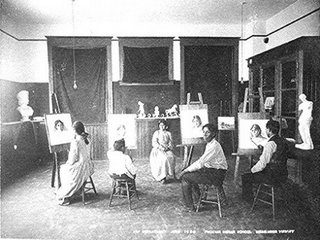
Art class, Phoenix Indian School, Arizona. Photographed by Messinger, June 1900. American Indian Select List number 161.
While we were in the area, I had been wanting to drive past the Phoenix Indian School and see it again, but it wasn’t the way I remembered it. I expected to see a big old building right next to the street, but instead it’s a large grassy park with a few smaller buildings set back from the road. Maybe I’m thinking of something else, or maybe the building I’m thinking of was torn down. Because they say that the rubble wall of the waterfall (behind the ampitheater) is recycled from an old Phoenix Indian School building. The architect also saved the WPA (Works Progress Administration) stamps from the original sidewalks and incorporated these into rubble walls throughout the park.
Today the complex is called Steele Indian School Park, and it’s one of the biggest parks in Phoenix. A wide circular walkway called “The Circle of Life” is at the heart of the park. In the center is a concrete water cistern on which is etched a poem that explains the American Indian design theme of the park. The Arbor Bridge and Entry Garden features a spiraling walkway that winds its way past native desert plants. There are columns with plaques on them and descriptive texts about the history of the school. The park also has a green area with grass and trees, an amphitheater, lake, dog area, and neighborhood playground. I don’t know why they would demolish some historic buildings and choose to save others, but three of the old buildings remain:
Memorial Hall – This auditorium was built in 1922 to honor the students who fought in WWI, and it will be restored as an auditorium.
Band Building – Built in 1933, this building started out as the elementary school and later became the band building. It will be remodeled into Museum/Administrative Offices.
Dining Hall – Built in 1901, the dining hall will become a Native American Cultural Center and Museum.
Founded in 1891, the United States Industrial Indian School at Phoenix, later known as the Phoenix Indian School, was a coeducational, federal boarding school. Native American Indian children were brought from the reservations to be educated and assimilated into the white man's culture. The campus had fourteen brick and twenty frame buildings which included a large schoolhouse, a two-story building containing employee quarters and a student dining hall, a shop for vocational training, several dormitories, a bathhouse, boiler house, water and sewer system. There were acres of fields where they grew hay, turnips, cabbages, tomatoes, and melons. They also had horses, mules, cattle, pigs, ducks, turkeys, and chickens. These provided for the vocational education of the students and also contributed to the school’s self-sufficiency.
An act of Congress, signed by President Ronald Reagan in November 1988, was to close the Phoenix Indian School and pass its administration from the Bureau of Indian Affairs to the National Park Service. Nineteen students, the last graduating class, walked up to the stage inside Memorial Hall and received their diplomas on May 24, 1990.
Websites
http://phoenix.gov/PARKS/sisp.html (Steele Indian School Park.)
http://www.archaeology.org/online/features/phoenix/ (Archaeology of the Phoenix Indian School.) Labels: downtown, history, Museum, park, Phoenix, schoolhouse

